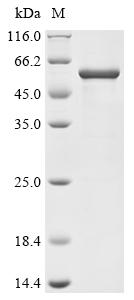NFkB p50 peptide
GTX27550
ApplicationsNeutralisation/Blocking
Product group Proteins / Signaling Molecules
Overview
- SupplierGeneTex
- Product NameNFkB p50 peptide
- Delivery Days Customer9
- Application Supplier NoteFor BL: Intended for use as a control peptide when used with anti-Human NFkB p50 (NFKB1) (GTX27549) to block specific interaction of anti-Human NFkB p50 (NFKB1) with the Human NFkB p50 (NFKB1) subunit. Control peptide should be used at 1.0 mg per 1.0 ml of antiserum in per assay. Optimal dilutions/concentrations should be determined by the researcher.
- ApplicationsNeutralisation/Blocking
- CertificationResearch Use Only
- ConjugateUnconjugated
- Scientific DescriptionNFkB is a transcription regulator that is activated by various intra- and extra-cellular stimuli such as cytokines, oxidant-free radicals, ultraviolet irradiation, and bacterial or viral products. NF-kB is a family of transcription factors that consists of homo- and heterodimers of NFkB1/p50 and RelA/p65 subunits, and controls a variety of cellular events including development and immune responses. All members share a conserved amino-terminus domain that includes dimerization, nuclear localization, and DNA binding regions, and a carboxy-terminal transactivation domain. Serines 529 and 536 in the transactivation domain of RelA/p65 are phosphorylated in response to several stimuli including phorbol ester, IL-1alpha and TNF-alpha as mediated by IkB kinase and p38 MAPK. Serine 529 is located in a negatively charged region (amino acids 422-540) that is phosphorylated in response to phorbol myristate acetate plus calcium ionophore activation. Phosphorylation of serines 529 and 536 is critical for RelA/p65 transcriptional activity. Activated NF-kB translocates into the nucleus and stimulates the expression of genes involved in a wide variety of biological functions. Inappropriate activation of NF-kB has been associated with a number of inflammatory diseases while persistent inhibition of NF-kB leads to inappropriate immune cell development or delayed cell growth.
- Storage Instruction-20°C
- UNSPSC12352202

